AckermannTh. (ed) Wind Power in Power Systems
Подождите немного. Документ загружается.

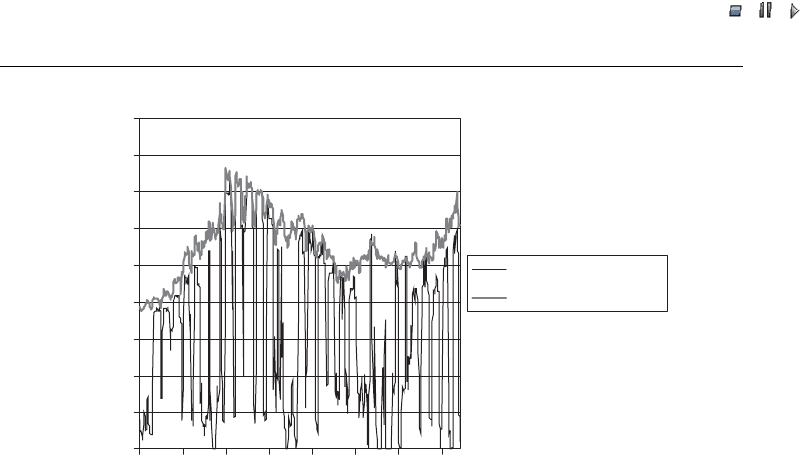
//INTEGRAS/KCG/P AGIN ATION/ WILEY /WPS /FINALS_1 4-12- 04/0470855088_ 19_CHA18 .3D – 401 – [383–410/28]
17.12.2004 10:41PM
18.4.3.2 The impact of large amounts of wind power on the power price
Wind power is expected to influence prices in the power market in two ways. First, wind
power normally has a low marginal cost and therefore enters close to the bottom of the
supply curve. This, in turn, shifts the supply curve to the right, resulting in a lower
system power price, depending on the price elasticity of the power demand. If there is no
congestion in the transmission of power, the system price of power is expected to be
lower during periods with high wi nds compared with periods wi th low winds.
Second, as mentioned above, there may be congestion in power transmission, espe-
cially during periods with high wind power generation. Thus, if the available transmis-
sion capacity cannot cope with the required power export, the supply area is separated
from the rest of the power market and constitutes its own pricing area. With an excess
supply of power in this area, conventional power plants have to reduce their produ ction,
because wind power normally will not limit its power production. In most cases, this will
lead to a lower power price in this submarket.
Figure 18.8 shows how the large capacity of wind power in the Western Denma rk
area affects the power system price. Five levels of wind power production and the
corresponding system power prices are depicted for each hour of the day during periods
without any congestion of transmission lines. As shown, the greater the wind power
production, the lower the system power price. At very high levels of wind power
production, the system price is reduced significantly during the day but increases at
night. This phenomenon is difficult to explain. It could be a consequence of spot market
bidders expecting high nocturnal levels of wind power. Nevertheless, there is a signifi-
cant impact on the system price, which might increase in the long term if even larger
shares of wind power are fed into the system.
0
100
200
300
400
500
600
700
800
900
1
77
153
229
305
381
457
533
609
685
Hours in December 2002
West Denmark price
System price
Price (DKr/MWh)
Figure 18.7 Deviations of the price of power in Western Denmark from the system price of Nord
Pool
Wind Power in Power Systems 401
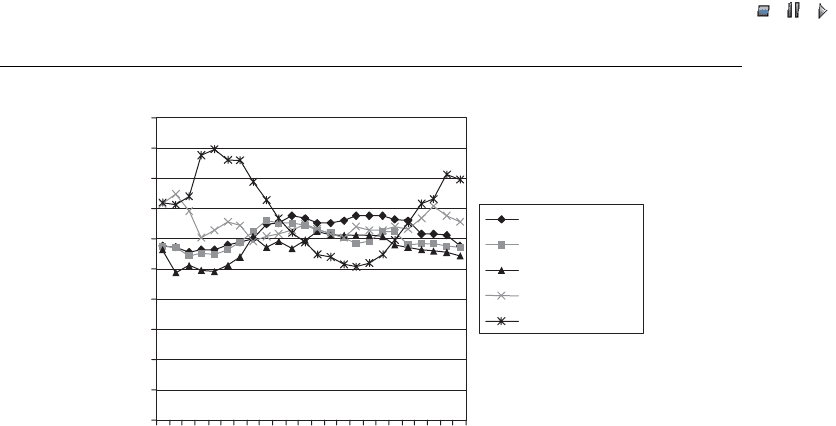
//INTEGRAS/KCG/P AGIN ATION/ WILEY /WPS /FINALS_1 4-12- 04/0470855088_ 19_CHA18 .3D – 402 – [383–410/28]
17.12.2004 10:41PM
The second hypothesis concerns power prices in cases where transmission line
capacity is completely utilised. As shown in Figure 18.6, during December 2002 the
share of wind-generated electricity in re lation to total power consumption for the
Jutland–Funen area was close to 100 % at certain points in time. This means that at
that time all power consumption could be supplied by wind power in this area. If
the prioritised production from decentralised CHP plants is added on top of wind
power production, there are several periods with an excess supply of power. Part of
this excess supply might be exported. However, when transmission lines are com-
pletely utilised, we have a congestion problem. In that case, equilibrium between
demand and supply has to be reached within the specific power area, requiring
conventional producers to reduce their production, if possible. The consequence to
the market is illustrated in Figure 18.9. Again, five levels of wind power production
and the corresponding power prices for the area are depicted for each hour of the
day during periods with congestion of transmission lines to neighbouring power
areas. As shown in Figure 18.9, there is a significant correlation between wind
production and power price. Thus, the greater the wind power production, the
lower the power price in the area.
The size of the impact of wind power on the power price at the spot market will
depend heavily on the amount of wind power produced and the size and interconnec-
tions of the power market. Experience in Denmark shows the following:
.
Even within the large Nordic power system, wind power has a small but clearly
negative impact on the power price. The more wind power that is supplied the lower
the power system price.
.
When Western Denmark is economically separated from the rest of the power market
because of congestions of transmission lines, wind power has a strong and clearly
negative impact on power prices, both during the day and during the night.
0
50
100
150
200
250
300
350
400
450
500
1471013161922
Hour of the day
0–150 MW
150–600 MW
600–1000 MW
1000–1500 MW
>1500 MW
Price (DKr/MWh)
Figure 18.8 The impact of wind power on the spot power system price
402 Economic Aspects
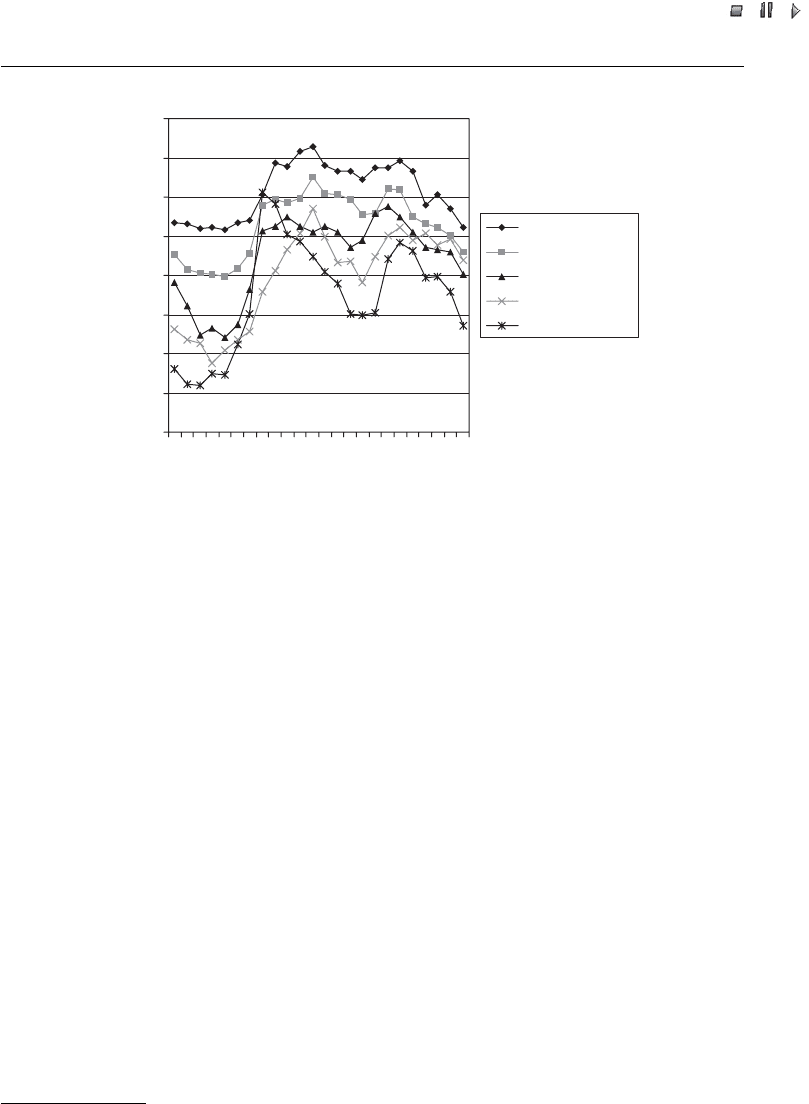
//INTEGRAS/KCG/P AGIN ATION/ WILEY /WPS /FINALS_1 4-12- 04/0470855088_ 19_CHA18 .3D – 403 – [383–410/28]
17.12.2004 10:41PM
18.4.4 Wind power and the balancing market
Currently, the transmission system operator in Western Denmark, Eltra, controls a
secondary control capacity of 550 MW upwards and 300 MW downwards. The secondary
control capacity is purchased via a tender process. According to Eltra, the capacity
demand for secondary control as a result of wind power has increased significantly. An
exact analysis of the additional secondary control requirements is difficult, because Eltra
can also buy secondary control capacity on the balance market in Sweden and Norway.
The balance market has similar requirements on generation as secondary control (i.e.
generation must be up and running 15 minutes after an order). In general, the cheapest
alternative for manual secondary control is used; however, in the case of network
congestion the local contracts must be used. The balance market in Sweden and Norway
can be considered competitive, which is not always the case with similar balance
markets.
(7)
The impact of wind power in Denmark on the Swedish–Norwegian balance
market will therefore be discussed next in more detail.
18.4.4.1 The balancing market
If forecasted production and actual deman d are not in balance, the regulating market
has to step in. This is especially important for wind-based power producers. The
0
50
100
150
200
250
300
350
400
1 4 7 10 13 16 19 22
Hour of the day
0–150 MW
150–600 MW
600–1000 MW
1000–1500 MW
>1500 MW
Price (DKr/ MWh)
Figure 18.9 The impact of wind power on the spot power price of Western Denmark, when there
are congestions in the power system between countries
(7)
If the power plants that are technically capable of participating in balance services are in the hands of a small
number of market participants (i.e. former monopolists) these market participants may exercise market power
to influence the prices for balancing services. Often, these higher prices are used to determine the costs of
balancing wind power production, even though the determination of the costs is based on an inefficient
market.
Wind Power in Power Systems 403
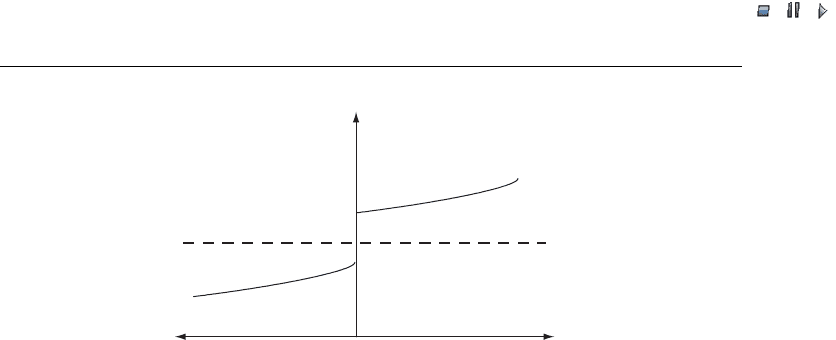
//INTEGRAS/KCG/P AGIN ATION/ WILEY /WPS /FINALS_1 4-12- 04/0470855088_ 19_CHA18 .3D – 404 – [383–410/28]
17.12.2004 10:41PM
producers that take part in the balancing market submit their bids to the balancing
market 1–2 hours before the actual production hour, and power production from the
bidding actors should be available within a notice of 15 minutes. For that reason, only
fast-responding power capacity will normally be able to supply regulating power.
Usually, wind power production can be predicted 12–36 hour s in advance to only a
limited extent. Thus it will be necessary to pay a premium for the difference. Figure 18.10
shows how the regulating market works. If the power production from the wind
turbines exceeds the initial production forecast, other producers will have to regulate
down. In this case, the price that the wind power producer gets for the produced excess
electricity is lower than the spot market price. If wind power production is lower than
the initial forecast, other producers will have to regulate up to secure the power supply.
These other producers will get a price above the spot market price for the extra
electricity produced – an additional cost, that has to be borne by the wind power
producer. The larger the difference between forecasted and actual wind power produc-
tion, the higher the expected premium, as shown in Figure 18.10 by the difference
between the regulatory curves and the stipulated spot market price.
Until the end of 2002, each country participating in the Nord Pool market had its own
balancing market. Thus, the above approach is fairly close to the Norwegian way of
operating the balancing market. In Denmark, balancing was handled by agreements
with the largest power producers. In addition, the transmission system operator (TSO)
had the option to purchase balancing power from abroad if the domestic producers were
too expensive or not able to produce the required volume of regulatory power. A
common Nordic regulatory market was established at the beginning of 2003.
When bids have to be submitted to the spot market 12–36 hours in advance it will not
be possible for wind producers to generate the forecasted amount at all times. If other
power producers are to regulate and compensate for the unfulfilled part, this causes
costs, and with wind power gradually entering the spot market, in the future this cost
will have to be borne by the owners of wind power plants. Until the end of 2002, the
TSOs were obliged to handle the regulation in Denmark, wind power being prioritised
dispatch. Since the beginning of 2003 the owners of wind turbines supplying the spot
market have been financially responsible for ba lancing the power themselves. They can
either continue to let the TSOs handle the balancing and pay the associated costs or they
Regulation Up
Price
Spot market price
Down
Figure 18.10 The functioning of the balancing market
404 Economic Aspects
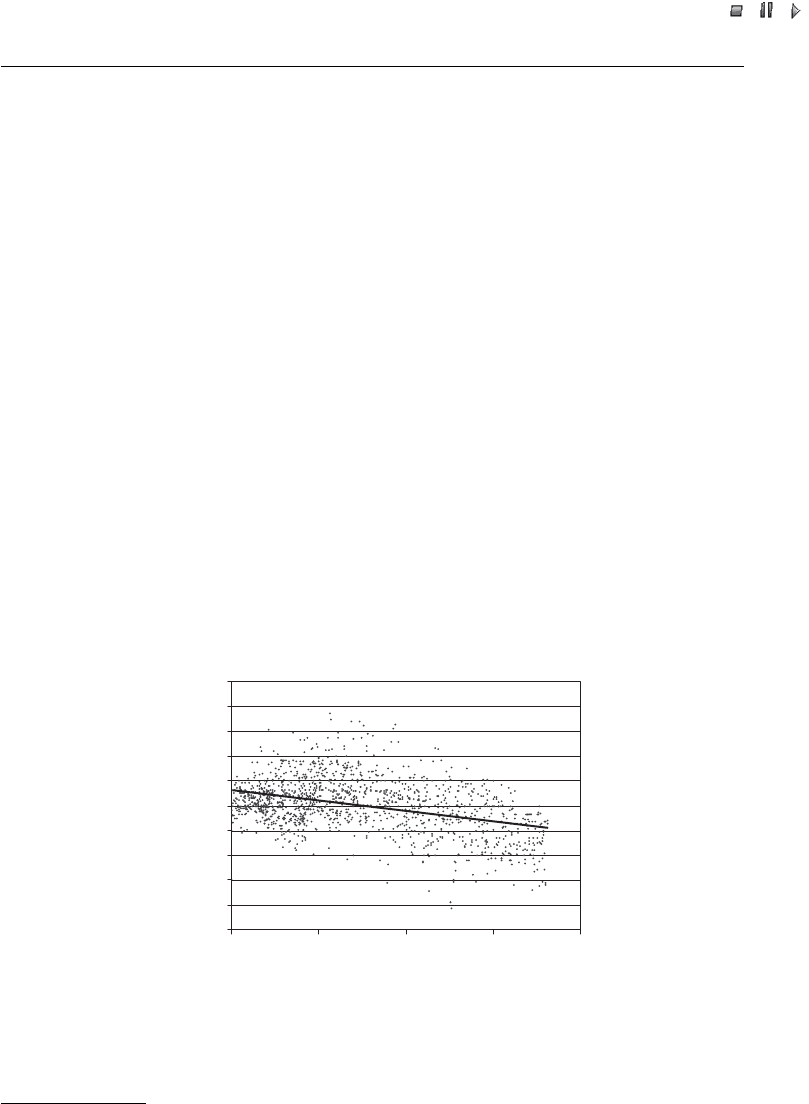
//INTEGRAS/KCG/P AGIN ATION/ WILEY /WPS /FINALS_1 4-12- 04/0470855088_ 19_CHA18 .3D – 405 – [383–410/28]
17.12.2004 10:41PM
can contract private companies to do this work. In Denmark, some wind turbine owners
have formed a cooperative for handling the spot market trading and balancing of their
turbines. At the time of writing, the majority of owners in the spot market are in this
cooperative.
18.4.4.2 The need for balancing of wind power
When wind power cannot produce according to the production forecasts submitted to
the power market, other producers have to increase or reduce their power production in
order to make sure that demand and supply of power are equal (balancing). But other
actors on the spot market also might require balancing power, owing to changes in
demand, shutdowns of power plants and so on. Now, the Danish TSOs have joined the
common Nordic balancing market, but, until 2003, most, if not all, of the balancing was
performed within the separate TSO areas.
(8)
The capacities shown in Figure 18.11 are related to all regulation (i.e. not only to
regulation in connection with wind power failing to produce at the forecasted produc-
tion level).
(9)
Nevertheless, although not very significant, there is a clear tendency that
the more wind power produced, the higher the need for down-regulation. Correspond-
ingly, the less wind power produced, the higher the need for up-regulation. Note that
Figure 18.11 shows that forecasts for wind power production tend to be too low when
–1000
–800
–600
–400
–200
0
200
400
600
800
1000
0 500 1000 1500 2000
Wind power (MW)
Down-regulation
Power (MW)
Up-regulation
Figure 18.11 Regression analysis of down-regulation or up-regulation against the amount of
wind power for the Jutland–Funen area: hourly basis for January–February 2002
(8)
In the Nordic region, Norway, Sweden and Finland each have their own TSO. Because there is no
interconnection over the Great Belt, Denmark is divided into two TSO areas, similar to the pricing areas in
Denmark.
(9)
From the available data, it is not possible to discern the specific cases when wind power failed to produce
according to the forecasts.
Wind Power in Power Systems 405
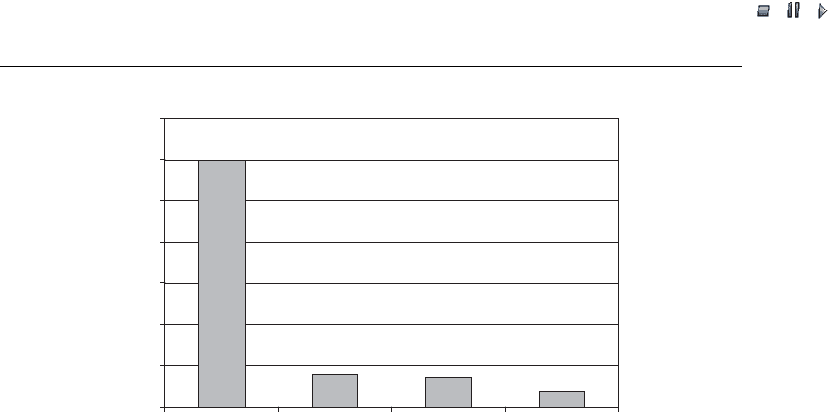
//INTEGRAS/KCG/P AGIN ATION/ WILEY /WPS /FINALS_1 4-12- 04/0470855088_ 19_CHA18 .3D – 406 – [383–410/28]
17.12.2004 10:41PM
large amounts of wind power are produced and tend to be too high when only small
amounts of wind-generated power are fed into the system.
Figure 18.12 compares power areas with different capacities of wind power and shows
that wind power strongly increases the need for regulation. Note that at the Nordic
power market the bidding for the spot market is carried out 12–36 hours in advance,
which is one of the reasons why wind power often requires regulatory power.
Sweden and Finland comprise large areas and have very little wind power capacity.
Zealand (the Eastern part of Denmark) has approximately 10 % of wind-generated
power in relation to total domestic power consumption, whereas Jutland–Funen (the
Western part of Denmark), as mentioned, has a coverage of more than 20 % of total
power consumption. Figure 18.12 clearly illustrates the consequences for the regulation
of power. In the Western Denmark area, regulation as a percentage of consumption is
more than six times higher than in the other areas.
In general, more wind power in the power system should be expected to increase the
need for regulation. However, the closer the time of gate closure to the actual time of
dispatch, the smaller the divergence between actual wind power production and the
submitted production bids should be.
18.4.4.3 The cost for balancing of wind power in the power market
In the Nordic power market, wind turbine owners who produce more than their initial
production forecast will receive the spot price for all their production. However, they
will have to pay a premium because other power plants have to regulate down as a result
of the production exceeding the forecast. If the owners produce less than their bid, they
will correspondingly have to pay a premium for the part that other generators have to
produce in up-regulation. Figure 18.13 shows the co sts of regulation in the Jutland–
Funen area of Denmark on an hourly basis for January and February 2002.
0
1
2
3
4
5
6
7
Jutland–Funen Zealand FinlandSweden
Regulation (%)
Figure 18.12 The need for regulation depending on the amount of wind power in the power
system. Note: regulation is shown as a percentage of consumption
406 Economic Aspects
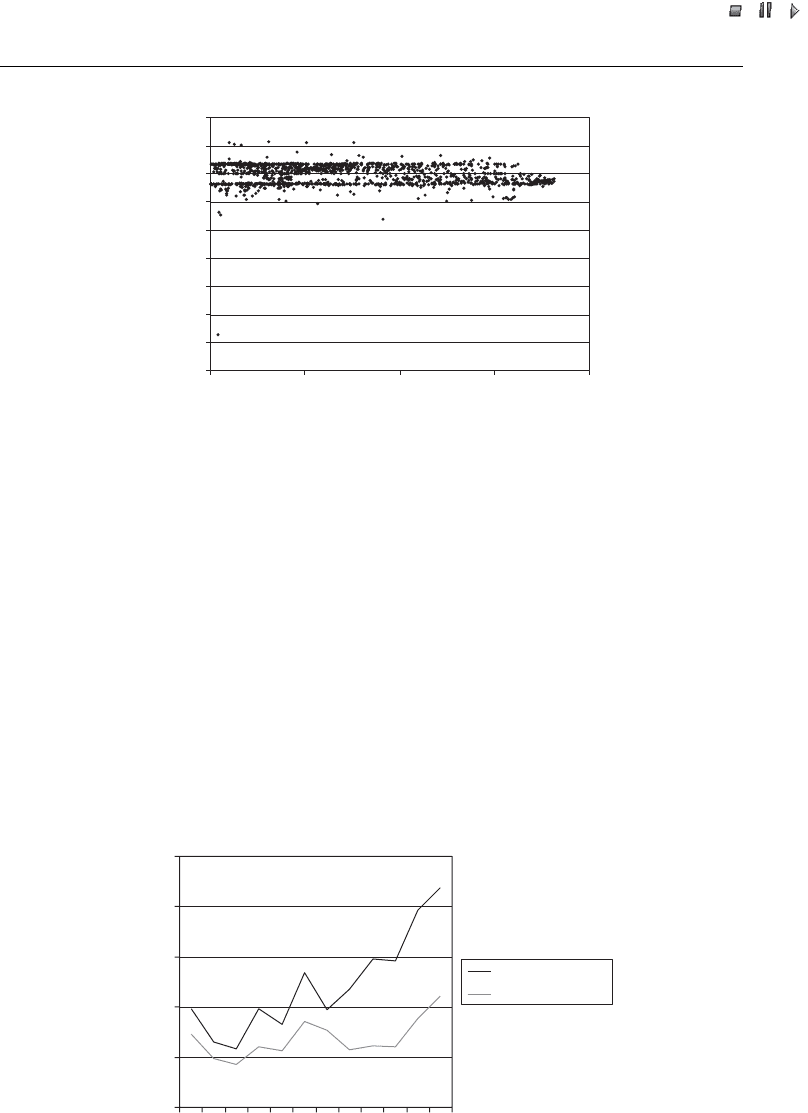
//INTEGRAS/KCG/P AGIN ATION/ WILEY /WPS /FINALS_1 4-12- 04/0470855088_ 19_CHA18 .3D – 407 – [383–410/28]
17.12.2004 10:41PM
The picture shows a clear ‘band’ of costs, both for up-regulation and for down-
regulation, almost independent of how much wind power is generated during the hour
in question. Even though the need for regulation increases with higher quantities of
wind power production, the regulating costs appear to be almos t independent of the
level of required regulation. During January–February 2002, the average cost of regu-
lating up reached E 8 per MWh regulated, and the corresponding cost of regulating
down amounted to E6 per MWh.
Figure 18.14 shows the regulation costs for the whole of 2002, calculated as monthly
averages. As the figure shows, the cost of up-regulation is constantly above the cost of
down-regulation, probably because the marginal cost of up-regulation is higher than for
power producers regulating down. Mo reover, as expected, the cost of regulation – again,
especially up-regulation – increases with the general level of the spot price, which
–1400
–1200
–1000
–800
–600
–400
–200
0
200
400
0 1000 1500 2000
Wind power (MW)
500
Cost (DKr/MWh)
Figure 18.13 The cost of regulation in the Jutland–Funen area: hourly basis for January–
February 2002
0
5
10
15
20
25
Jan Mar May Jul Sep Nov
Up-regulation
Down-regulation
Cost (€/MWh)
Figure 18.14 The cost of regulation, calculated as monthly averages for the year 2002 for the
Jutland–Funen area
Wind Power in Power Systems 407
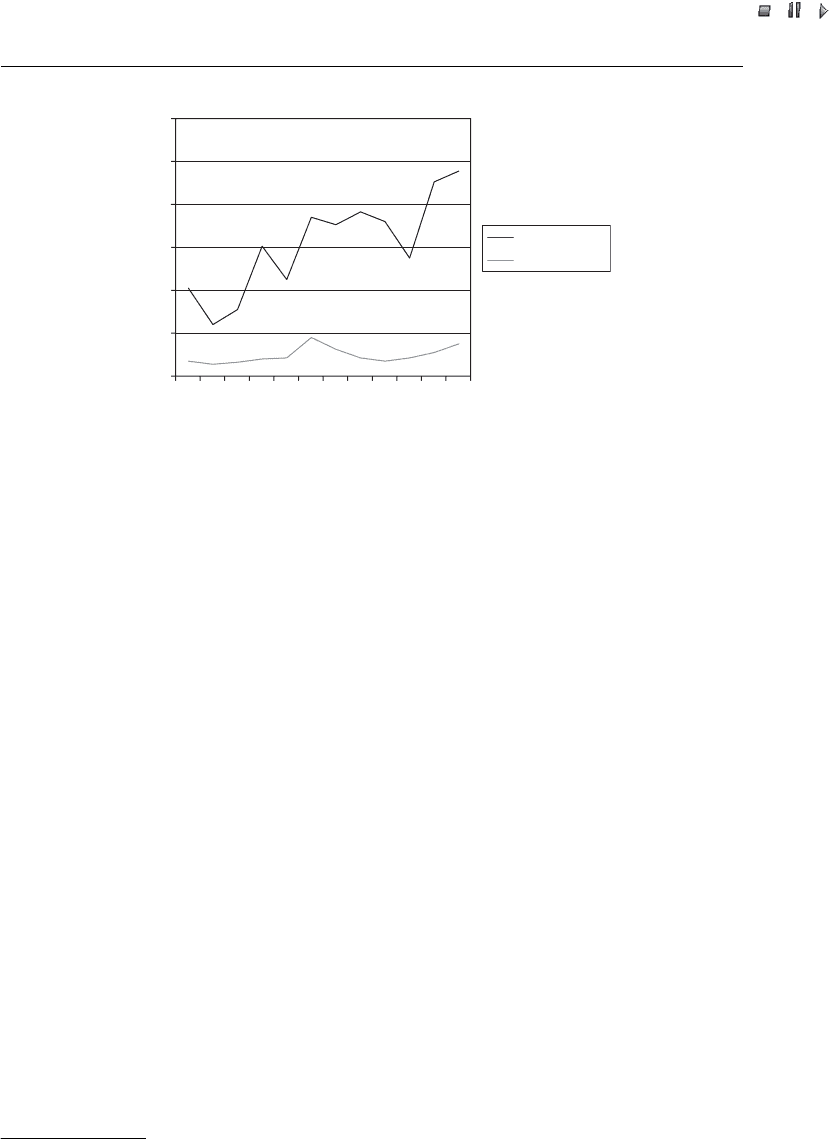
//INTEGRAS/KCG/P AGIN ATION/ WILEY /WPS /FINALS_1 4-12- 04/0470855088_ 19_CHA18 .3D – 408 – [383–410/28]
17.12.2004 10:41PM
increases substantially towards the end of 2002.
(10)
In 2002, the average up-regulation
cost reached E12 per MWh regulated, and the cost of down-regulation amounted to E7
per MWh regulated.
As already mentioned, the regulated quantities relate not only to wind power but also
to the total system, includi ng nonfulfilment of bids from demand and conventional
power producers as well. The estimate constitutes the upper limit. In Figure 18.15 we
relate the 2002 monthly regulation costs for the Western part of Denmark to wind
power only. Finally, Figure 18.15 gives the corresponding costs related to the total
power supply.
Figure 18.15 sho ws that regulation co sts per megawatt-hou r borne by wind power
only are lowest during periods with plenty of wind-generated power (i.e. during Winter
and Spring 2002), and higher during the summer, when less wind power is produced.
However, the high spot prices of Autumn and Winter 2002 are an exception. For the
year 2002, the average regulation cost if borne by wind power amounts only to E3 per
MWh.
(11)
As mentioned above, these estimates constitute an upper limit of the regula-
tion costs for wind energy, because the regulated quantities do not relate purely to wind
power. If the regulation co sts are distributed across the total power supply, the cost per
megawatt-hour is, of course, much lower and , if calculated as an average for 2002, the
cost amounts to E0.5 per MWh.
18.5 Conclusions
Power systems in most countries were designed around conventional generation sources
such as coal, gas, nuclear or hydro generation. Nevertheless, wind power can reach a
0
1
2
3
4
5
6
Jan
Feb
Mar
Apr
May
Jun
Jul
Aug
Sep
Oct
Nov
Dec
Wind only
Total supply
Cost (€ / MWh)
Figure 18.15 Regulation costs calculated as monthly averages for the Jutland–Funen area for
2002: costs incurred either by wind power only or in relation to the total power supply
(10)
At the end of 2002, there was a draught in Norway and Sweden and the power system prices reached
extremely high levels.
(11)
It is not known whether 2002 is a representative year for regulating costs.
408 Economic Aspects

//INTEGRAS/KCG/P AGIN ATION/ WILEY /WPS /FINALS_1 4-12- 04/0470855088_ 19_CHA18 .3D – 409 – [383–410/28]
17.12.2004 10:41PM
significant penetration level in these power systems, although the integration of wind power
may require a redesign of the power system and/or a change in power system operation,
which might affect the cost of the overall power supply. In general, the optimum penetra-
tion level of wind power is hardly a technical problem; it is more of an economic issue.
The costs are related to interconnection and network upgrade costs as well as the
increasing requirements for power system balancing (i.e. secondary control). Different
approaches for the allocation of interconnection costs and upgrade costs can be used,
depending on the overall goal. It is important to consider that certain interconnection
charges (e.g. deep connection charges) may generate significant barriers for the deploy-
ment of wind energy.
In general, the costs of integrating wind energy into the power system depends on the
amount of wind power in relation to the overall power market and the design of the power
exchange, which can also significantly influence the requirements for secondary control.
Experience from the Western Denma rk power system where wind power capacity
corresponds to approximately 20 % of power consumption results in the following
conclusions:
.
Although wind-generated power exceeded domestic demand for electricity during
several hours, there were no system failures as a result of too much wind power in
the system. This means that the system operator was able to handle these large
amounts of wind and decentralised CHP. If CHP plants were not treated as prioritised
dispatch then even more wind power might be integrated into the system.
.
Even within the large Nordic power system, wind power has a small but clearly
negative impact on the power price. The more wind power that is supplied the lower
the power system price.
.
If W estern Denmark is economically separated from the rest of the power market
because of the congestion of transmission lines, wind power has a strong and sig-
nificantly negative impact on power prices, both during the day and during the night.
.
Although not very significant, there is a clear tendency for an increase in wind power
production to result in a larger need for down-regulation. Correspondingly, the less
wind power produced, the larger the need for up-regulation.
.
For 2002, the average cost of up-regulation reached E12 per MWh regulated, and the
cost of down-regulation amounted to E7 per MWh regulated. In general, the cost of
up-regulation is higher than the cost of down-regulation. For the year 2002, the
average cost of regula tion if born by wind power amounts only to E3 per MWh for
wind-generated power (upper limit). If the costs are distributed across the total power
supply, the regulation costs are much lower, the average cost for 2002 amounting to
E0.5 per MWh.
References
[1] Ackermann, T. (2004) Distributed Resources in a Re-regulated Market, PhD thesis, Department of Elec-
trical Engineering, Royal Institute of Technology, Stockholm, Sweden.
[2] Massy, J. (2004) ‘A Dire Start that Got Gradually Better’, Windpower Monthly (February 2004) 46.
[3] Nord Pool (2003). http://www.nordpool.com.
Wind Power in Power Systems 409

//INTEGRAS/KCG/P AGIN ATION/ WILEY /WPS /FINALS_1 4-12- 04/0470855088_ 19_CHA18 .3D – 410 – [383–410/28]
17.12.2004 10:41PM
[4] Ofgem (Office of Gas an Electricity Markets) (2003) Structure of Electricity Distribution Charges – Initial
Decision Document, November 2003, available at http://www.ofgem.gov.uk/.
[5] Watson, J. (2002) ‘The Regulation of UK Distribution Networks: Pathways to Reform’, in Proceedings of
the Second International Symposium on Distributed Generation: Power System and Market Aspects,
Ed. T. Ackermann, Royal Institute of Technology, Stockholm, Sweden.
410 Economic Aspects
